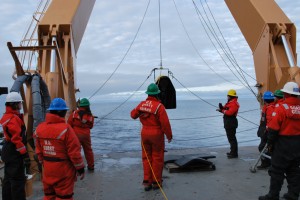17 December 2014
New evidence for a massive flood on the Mackenzie River 13,000 years ago
Posted by kwheeling
By Rex Sanders

Coast Guard crewmembers lower a chirp sonar from the USCGC Healy into the Arctic Ocean.
Credit: Steve Walters
The Northern Hemisphere suddenly cooled about 12,800 years ago in an event named the Younger Dryas. Scientists have debated the cause for many years. One widely-believed explanation is that the massive but long gone Lake Agassiz in central Canada rapidly flooded fresh water east down the St. Lawrence River into the northern Atlantic Ocean. That pulse of fresh water interfered with warm ocean currents and triggered the cooling.
In 2010, geographer Julian Murton of the University of Sussex and colleagues found evidence of a gigantic flood along the Mackenzie River in Canada. They proposed that Lake Agassiz flooded north down the Mackenzie into the Arctic Ocean. This fresh water pulse spilled over into the Atlantic Ocean and triggered the Younger Dryas, they said.
Recently, scientists from the Scripps Institution of Oceanography in California and the Woods Hole Oceanographic Institution in Massachusetts discovered a massive deposit of Arctic seafloor sediment consistent with a huge flood coming down the Mackenzie River about 13,000 years ago. Shannon Klotsko, a PhD candidate at Scripps, presented the team’s findings in a poster session Monday afternoon at the American Geophysical Union Fall Meeting in San Francisco.
“Did it cause the Younger Dryas? The timing seems right, but there’s been some discussion about what lakes it was sourced from,” said Klotsko.
In 2013, the researchers retrieved sediment cores and used a chirp sonar to measure sediment layers beneath the Arctic Ocean near the mouth of the Mackenzie River.
In one core just west of the river delta, the scientists found a layer with much larger particles than the other layers and sudden changes in five other sediment properties. That layer was just beneath a seven-meter-thick section of unusually uniform sediment. Carbon-14 dating of core samples also pointed to a dramatic increase in how quickly the sediment accumulated in that section – from less than 0.5 meters per thousand years before and after the flood, to as high as 12 meters per thousand years during the flood.
“In geologic time, it’s very fast,” said Klotsko.
The researchers also found the thickest flood deposits west of the Mackenzie – consistent with a massive outpouring of sediment from the river carried westward by ocean currents.
Klotsko and her colleagues believe that with this additional evidence, the case for Lake Agassiz suddenly flooding down the Mackenzie River might be more secure.
Rex Sanders is a science communication graduate student at UC Santa Cruz.



 GeoSpace is a blog on Earth and space science, managed by AGU’s Public Information staff. The blog features posts by AGU writers and guest contributors on all sorts of relevant science topics, but with a focus on new research and geo and space sciences-related stories that are currently in the news.
GeoSpace is a blog on Earth and space science, managed by AGU’s Public Information staff. The blog features posts by AGU writers and guest contributors on all sorts of relevant science topics, but with a focus on new research and geo and space sciences-related stories that are currently in the news.